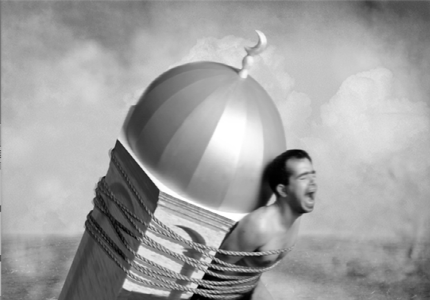By Sara G. Levin
In “Aoudah (recurrences),” a digitally enhanced photo by artist Wafaa Bilal, a man screams beneath the weight of a mosque, strapped to his back. Having grown up during the Iran-Iraq War, Bilal knows firsthand the anguish emanating from his artwork, arguably the most powerful in the “Detained” exhibition now on view at the Asian American Arts Centre Downtown.
Questions of race, religion and politics connect each piece in the show, which runs through May 5. Using photography, video, sculpture and paintings, artists confront the kind of racial and religious prejudices that have affected Asian Americans as well as Arab Americans post 9/11, said Bob Lee, the exhibit’s curator. The works are intended to bridge Asian and Arab American cultures—even though not every artist is of Arab or Asian descent. Italian photographer Lina Palotta, for instance, contributes beautiful black and white photos of Afghan women living in New York. In one print, mother and daughter sit in prayer as the daughter curiously pokes her head from under a headscarf; the mother gives the camera a skeptical look.
“Any moment, a person of Asian American background could …become a headline in the news, could be identified as a bomber,” Lee said, referring specifically to Muslims from Southeast Asia. In Malaysia and Indonesia, Muslims make up a majority of the population.
Lee has invited James Yee, the military Muslim chaplain accused of aiding terrorists, to speak at the center this Saturday, April 8. Lee was jailed for 76 days in solitary confinement after working at Guantanamo Bay as a chaplain. Last year he published “For God And Country: Faith and Patriotism Under Fire,” a book about the injustices he saw there.
“The story of James Yee has a humanistic side,” Lee said. “Born and raised in New Jersey, like myself, his mother is Lutheran. He [was] attracted to the Muslim religion when he [was] in the Gulf War… He’s a bridge for us between these two worlds (Arab and Asian) because of his personal life and his spiritual choice.”
Lee, who says the exhibit was inspired by stories like Yee’s and that of Wen Ho Lee, a physicist who was suspected by the U.S. government of being an international spy, has actually been planning the exhibit for several years. It should have premiered last year, but was delayed when the center’s landlord threatened the gallery with eviction. Lee teamed up with Rabab Abdulhadi, director of the Center for Arab American Studies at the University of Michigan to coordinate the exhibit this year.
Across the center’s space, six tall color portraits by Naeem Mohamien hang like banners. They are intended to mimic a Gap clothing store ad called “Fresh, Casual, American Style.” People whose racial or religious backgrounds translated to jail time, deportation or asylum stare out like smug models. Mohamien is from the Visible Collective/DisappearedinAmerica .org project, which is also represented in the Whitney Biennial, and claims to trace backgrounds of people who have been detained post-9/11.
Every piece scrambles commonplace notions of patriotism, identity and repression, but not every artist does this as overtly as Mohamien and Bilal. Trong Nguyen, for example, piled sand, shells, pinecones and plastic bottles filled with written messages. His installation, called “Message From Guantanamo,” leaves the viewer to wonder what each untold story says.
Similarly, in “Social Imaginations,” provocative phrases are printed on white squares, such as “Pakistani; Sufi Muslim; New Haven” or “Bene Israeli; Jew; South-Asian American.” But artist Dorothy Imagire leaves us wondering whether her blocks represent real people, a combination of real people, or if they are completely imagined.
Although the center’s space is small, and some of the works might seem odd—like the video of artist Pia Lindman miming the feeling of sorrow in front of a Holocaust memorial in Vienna—the stories that lie beneath are sometimes more intriguing.
“Etched in my memory are visions of death, terror, and the anguish to the Iraqi people,” writes Bilal in his online biography.
“Nearly every night from childhood, the agonized screams of women who had just learned of their loved one’s death invaded my sleep.” Before coming to the United States, Bilal, an activist against Hussein’s regime, fled Baghdad and accidentally crossed into Kuwait, where he was accused of spying and detained.
The exhibition should be educational, said Lee. He hopes that the artwork inspires visitors to be vigilant of political climates that encourage detaining suspects based on race or religion. Unfortunately, some of the pieces are more visually striking than others, and most leave the viewer with more questions than answers. But the collection undoubtedly succeeds in uniting a needed collective voice against oppression.
“Detained” runs through May 5 at the Asian American Arts Centre, 26 Bowery Street (212 233-2154, www.artspiral.org).
WWW Downtown Express


































